What Is Decred?
Since 2016, Decred has striven to solve blockchain governance. Our innovative consensus voting model empowers stakeholders and allows for the seamless transition from one set of rules to another. Decentralized decision-making and self-funding have enabled us to build a robust, evolving digital currency, free from third party influence.
Their modular codebase offers unique adaptability and can scale to the latest blockchain technology. Decred’s technology enabled the world’s first successful direct on-chain user-activated consensus vote. This represents a revolutionary approach to stakeholder governance where our community directs the project and makes decisions together.
- Overview - Table of Contents
- What Is Decred?
- Getting Started With Decred
- How To Get A Decred Wallet?
- Decred Resources
- How To Buy Decred?
- How To Earn Decred?
- What Is Decred Mining?
- Latest Decred News
They are community-powered. Stakeholders who participate in Decred’s decision-making are rewarded for their efforts. Sustainable funding and a resilient contractor model allow for anyone to join Decred at any time and engage in its governance. Decred’s value is in the people who work on it - together they’re building the decentralized future we want to see.
Decred is built to last. Our development activity and quality are among the highest in the space. Features of the Decred software include:
- An innovative hybrid proof-of-work (PoW) proof-of-stake (PoS) consensus voting system
- A censorship-resistant blockchain-anchored public proposal platform
- Smart contracts that work such as Lightning Network
- Cross-chain atomic swaps between different digital currencies
- Cross-platform wallets for ease of use
Consensus Voting
Decred uses an innovative hybrid proof-of-work (PoW) proof-of-stake (PoS) system to give stakeholders decision-making power about the set of consensus rules to activate. This allows for a seamless transition from one set of rules to another while keeping the existing blockchain ecosystem intact.
Cross-platform Wallets
Decred features accessible wallets through graphical user interfaces (GUIs) across all major operating systems (Windows, macOS, and Linux). For more technical users, command line interface (CLI) wallets are also available.
Atomic Swaps
Decred does not require reliance on centralized exchanges. With cross-chain atomic swaps between different digital currencies, users can conduct trustless over-the-counter (OTC) trades without a third party.
Soon™
Decred enjoys active development. Current milestones include a full stakeholder-directed decentralized autonomous organization (DAO) and enhanced user privacy.
Lightning Network
Decred implements smart contracts that work. Lightning Network (LN) is one such application of a low-latency off-chain system that allows for near-instant micropayments in DCR. With LN, Decred directly competes with existing fiat payment systems.
These principles have been established in an effort to create an equitable and sustainable framework within which to achieve Decred's goal to be an autonomous and decentralized currency where all stakeholders have a real voice.
Free and Open-Source Software - All software developed as part of Decred shall be free and open source-software.
Incremental Privacy and Security - Privacy and security technology shall be implemented on a continuing and incremental basis, both proactively and on-demand in response to attacks.
Free Speech and Consideration - Everyone has the right to communicate opinions and ideas without fear of censorship. Consideration shall be given to all constructive speech that is based in fact and reason.
Multi-Stakeholder Inclusivity - Inclusivity represents a multi-stakeholder system and an active effort shall be maintained to include a diverse set of views and users.
Getting Started With Decred
Overview
Decred is a multi-platform digital currency with support for Windows, macOS, and Linux. Easy-to-use wallet apps enable sending, receiving, and mining Decred with just a few clicks.
For those who like to tinker, Decred provides a full suite of command line tools allowing customization of the Decred experience.
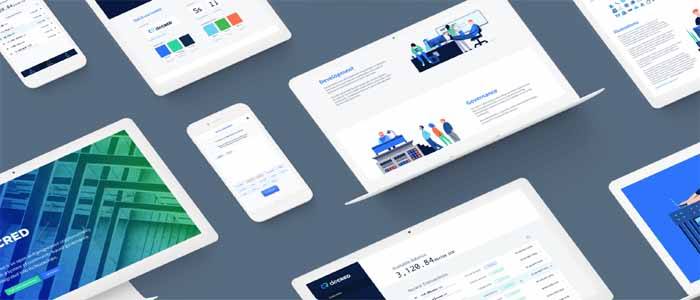
The Basics
There are three main ways to interact with Decred:
The Wallet - For sending and receiving funds as well as participating in PoS mining.
Proof-of-work Mining - Using computing power to validate transactions on the network and generate new Decred tokens.
Proof-of-stake Mining - Using funds to vote on important network development matters and validate transactions for rewards.
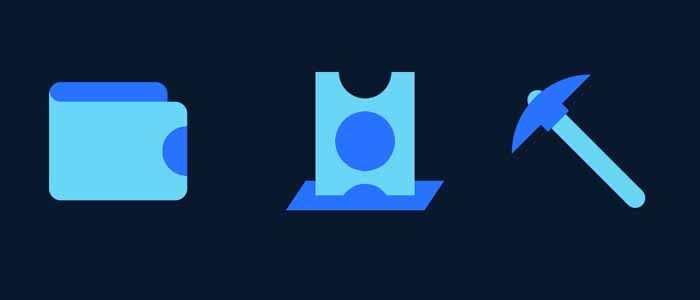
The Wallets
The Web Wallet is the easiest way to get started with Decred. All users can access it online via wallet.decred.org, without the need to download anything.
For Windows, macOS, and Linux users, Decrediton wallet is available.
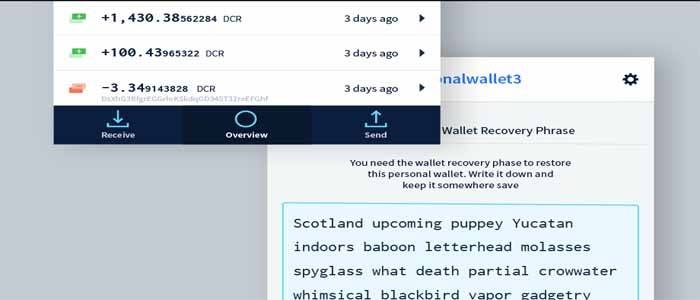
Send and Receive Decred
An address is the only thing needed to send or receive funds. It can be easily generated from any Decred wallet. Decred addresses always begin with D and contain 26-36 alphanumeric characters.
After a transaction is made, funds will usually clear in about 5 minutes. There is a small fee to help with the upkeep of the network. This fee is in addition to the transaction amount. That is, a transfer of 100DCR would incur a fee of about 0.006DCR.
The block explorers mainnet.decred.org and explorer.dcrdata.org allow users to search all the blocks and transactions in the Decred blockchain.
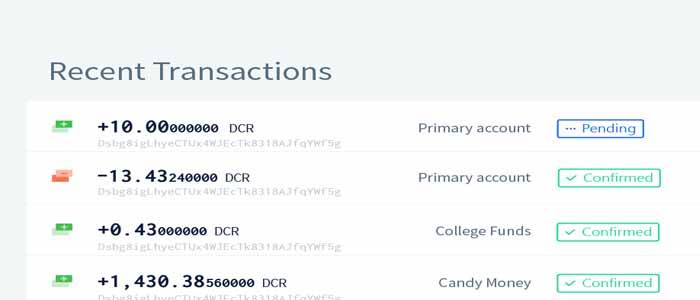
Mining
The term mining represents the process of validating transactions on the Decred network and keeping it secure. In return for work, miners are rewarded with newly generated Decred coins.
Decred has two methods of validating transactions: Proof-of-work (PoW) and Proof-of-stake (PoS).

Proof-of-work Mining
In Proof-of-work (PoW) transactions are grouped into blocks. These blocks are validated by PoW miners. When a block is validated it becomes a permanent part of the Decred network.
You can become a miner by dedicating spare computing resources to the network. In return miners are rewarded with Decred.
For efficiency and convenience you can join mining pools. The pools are groups of miners who share the work and split the reward. Joining a mining pool is an excellent way for smaller contributors to receive consistent payouts for their work.
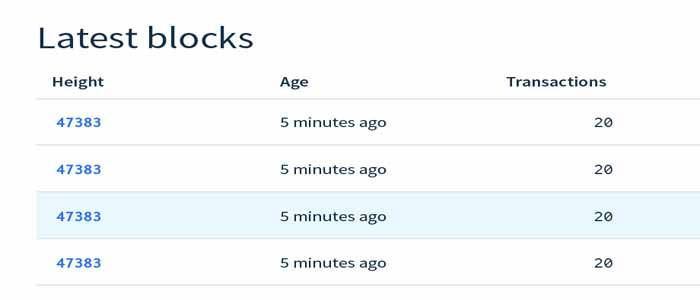
Proof-of-stake Mining
Unlike PoW, Proof-of-stake mining (PoS) requires little computing resources. Decred funds are used to purchase voting tickets on the network. In every block, five tickets from the pool of live tickets are chosen at random to vote on the validity of the previous block.
PoS adds an extra layer of decentralization to Decred and allows users to vote on suggested network changes. Pools are also available for PoS to ensure your tickets are ready to vote whenever they're called.
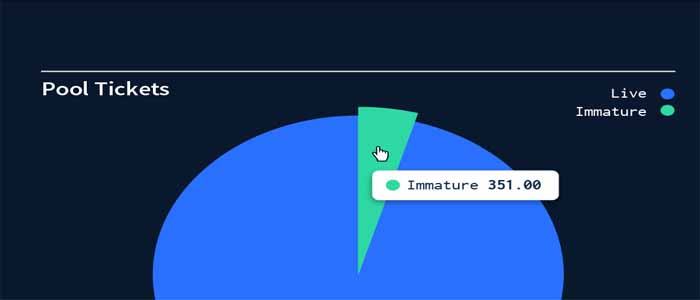
Buying and Trading Decred
Decred is still new, and at this time, the easiest way to purchase it is with Bitcoin. Once you have some Bitcoin, it can be traded for Decred at digital currency exchanges.
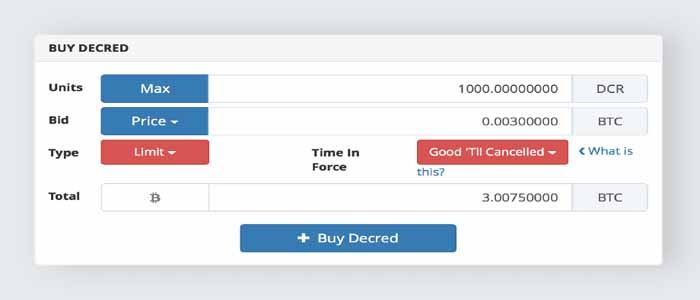
Join the Community
Through decentralized processes, people with different ideas, goals, and opinions can help shape the future. You will likely have some questions, so come join our growing community, where you can connect with developers and other users, get information, ask questions, or just hang out.
- Overview - Table of Contents
- What Is Decred?
- Getting Started With Decred
- How To Get A Decred Wallet?
- Decred Resources
- How To Buy Decred?
- How To Earn Decred?
- What Is Decred Mining?
- Latest Decred News
We have a user forum, IRC channel, Telegram channel, and Slack channel where you can chat with the developers and other users in real time. Don't forget Twitter and Reddit. We can't wait to meet you!

Planned Features
Part of the reward from new blocks goes towards the development of Decred to ensure that it will continually evolve to meet the needs and wants of the community now and in the years to come. These are just some of the features planned for 2017:
- Hard fork voting
- A stakeholder-directed DAO
- Decentralized control of development funds
- Lightning network support
- Continuous UI and Design development
- Enhanced privacy
- Payment integration

How To Get A Decred Wallet?
Paymetheus Setup Guide
Paymetheus is a simple to use graphical wallet for Decred. With it, you can send and receive DCR, purchase tickets for PoS voting, get a history of all your transactions and more. About the only thing Paymetheus doesn’t do is PoS voting.
Download and Install
The Windows Installer (.msi file) is located here: https://github.com/decred/decred-binaries/releases/tag/v1.1.0. It will install Paymetheus to your computer’s Program Files folder. Installation is pretty straightforward, but instructions are provided below:
1. Download the correct file:
For 32-bit computers, download the decred_1.1.0-release_x86.msi file.
For 64-bit computers, download the decred_1.1.0-release_x64.msi file.
2. Navigate to download location and double click the .msi file.
3. Follow the installation steps. Within this process you’ll be prompted to accept an End-User License Agreement.
4. After setup, the features should be installed to your ..\Program Files\Decred\ folder and accessible through the Start Menu (look for Decred in the Program list)
Start Paymetheus
You’re now ready to start using Decred! Start the ‘Decred’ program. You will now see the connection screen:
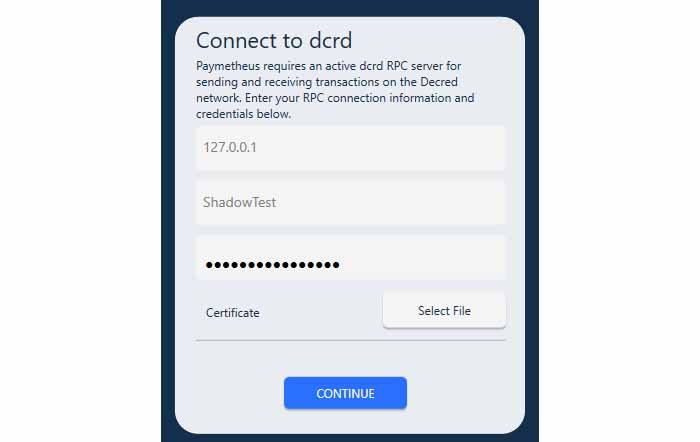
Two programs are actually running when you start Decred. There’s ‘Paymetheus’ which is the graphical wallet we’ll talk further about and ‘dcrd’ which is the communications daemon (pronounced DAY-mon; a program that runs in the background and that does not directly interact with a user) that actually talks to the Decred network. This means that you can run dcrd on another computer (such as an always on server) and then use Paymetheus to connect to it remotely.
The first time Paymetheus starts, it will download the blockchain in the background. This can take up to an hour.
Create or Restore Wallet
You will now have the option to create a new wallet or restore a wallet from a seed. If you’re reading this, you’re probably new and don’t already have a wallet so let’s create a new one. If you click restore, you will be asked to enter your seed words instead of being given a new seed. The rest of the process is the same. Click “Create a new wallet”. You will see the following screen:
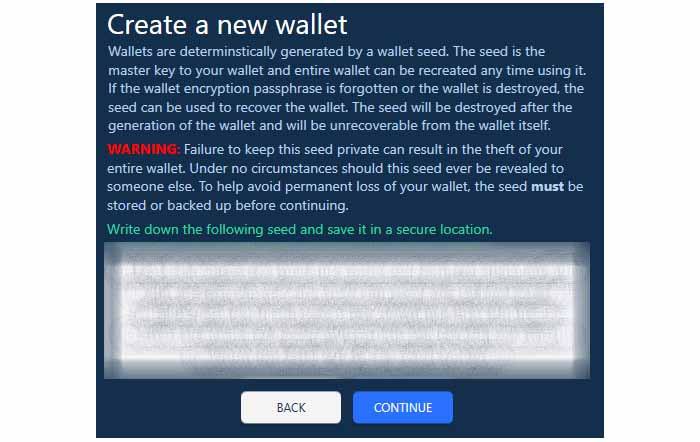
STOP HERE!!! DO NOT CLICK CONTINUE!
This is the most important part of using Decred. In the white box your seed words are displayed. These words are the key to your wallet. WITHOUT THESE WORDS OR THE HEX REPRESENTATION YOU WILL PERMANENTLY AND FOREVER LOSE ACCESS TO YOUR FUNDS!
DO NOT GIVE THEM TO ANYONE ELSE, NOT EVEN DECRED DEVELOPERS!
With these words, someone else can recreate your wallet on another computer and transfer all the funds out to another wallet. It is not possible to reverse a transaction in Decred, so if someone steals your Decred, there is no way to get it back.
DO NOT USE THE SAME SEED IN MULTIPLE WALLETS! Visit Wallets and Seeds FAQ to see why this matters. It is recommended that where possible a new wallet should mean generating a new seed.
Decred and other digital currencies are often described as being like a bank account. However, unlike with online banking, in the Decred system there is no trusted third party who holds your money on your behalf. You and you alone control your DCR, just like with physical cash. When cash or DCR is lost, misplaced, or stolen, it is most likely gone permanently.
- Overview - Table of Contents
- What Is Decred?
- Getting Started With Decred
- How To Get A Decred Wallet?
- Decred Resources
- How To Buy Decred?
- How To Earn Decred?
- What Is Decred Mining?
- Latest Decred News
If you lose your wallet, you lose access to whatever you had in it and no one, not even the Decred developers can get it back. So it’s very important that you take the time to read this page and WRITE DOWN the seed words in a safe place.
A good idea is to write them on a piece of paper and store them somewhere secure and also store them in an ENCRYPTED file on your computer. Cloud storage like Dropbox or OneDrive is fine when precautions are taken. Since online accounts can be hacked, you should strongly encrypt your wallet file (MS Word or Libre/OpenOffice can do this) before you upload it to a cloud storage service.
Okay, so you’ve secured your seed words in at least two different places. Click Continue. You are now asked to type them back in to ensure you have written them down correctly in case you need to restore your wallet later. Note you can’t paste them; you will need to type them. This is to make sure you have the words saved somewhere other than the clipboard. Do so and click Confirm.
Choose a Private Wallet Passphrase
Enter a passphrase to use whenever you create a transaction on the network. As long as your wallet is locked with this passphrase, your wallet funds are inaccessible to anyone who gains control over the wallet file. There is also the option here for a public passphrase.
It is used to encrypt all of the public data (transactions and addresses) within your wallet file so if it is stolen, an adversary can’t link you to your transactions. For most people, a public passphrase is usually overkill, so you can leave it unticked. Once you’ve entered your new private (and optional public) passphrase, click Encrypt.
Your wallet will now create and synchronize to the blockchain. This can take a few minutes on slower computers. Note that the seed words you wrote down will work with any Decred wallet application, not just Paymetheus.
The Paymetheus Windows Wallet
The overview tab gives a quick summary of your total DCR (spendable and locked), number of accounts and transactions as well as a list of recent account activity.
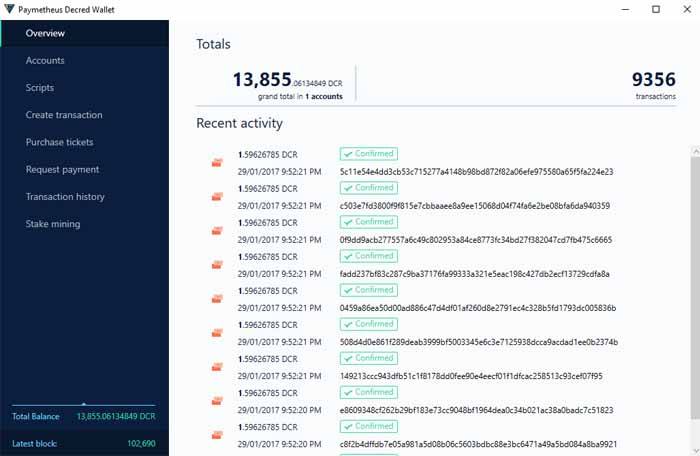
Accounts
The accounts tab shows you the accounts in your wallet and allows you to add new ones. Accounts in Decred work just like bank accounts. They allow you to keep separate records of your DCR.
This feature is most useful for those who run businesses and wish to keep separate accounts for tax records for example. Transferring DCR across accounts will create a transaction on the blockchain.

Scripts
Currently only used for PoS mining in a pool. As of version 0.8.0 script setup has been automated. See the Purchase Tickets section below for more information. It will be used for more advanced features in the future.
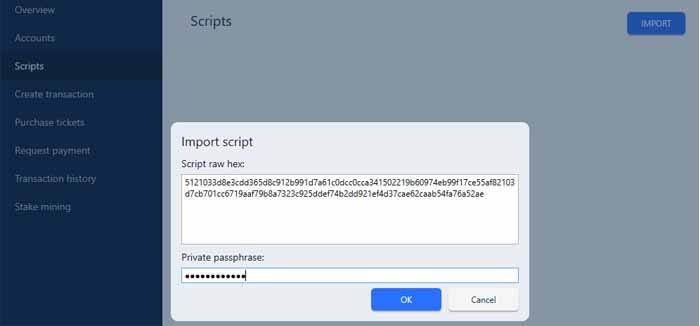
Create Transaction
This tab is how you send funds to another address. Simply copy the receiver’s address into the text box and type in the amount of Decred you wish to send. The estimated fee will be listed as well. You can click the ‘+’ button to send Decred to multiple addresses in the one transaction if you wish.
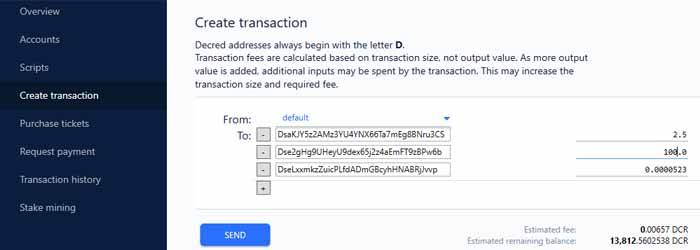
Purchase Tickets tab
Paymetheus is able to buy tickets for Proof of Stake mining by using its manual ticket purchasing features. Note that Paymetheus can only purchase tickets, it can’t do the actual voting. For that you will either need to setup solo PoS or use a PoS stake pool.
To join the pool, provide a public key address which can be used to generate a 1-of-2 multisignature script. The multisignature script will be generated by the pool and returned to you along with a P2SH address to give voting rights to.
Don’t worry if you didn’t understand that quote. What it means is that you create an address that can be accessed by two wallets. Only one wallet needs to be available to use the address. This means that the pool can vote on your behalf and you can vote using your own wallet if the pool stops working.
It DOES NOT give the pool access to your funds. All you are doing is granting voting rights to the pool. The pool does not touch your funds.
Official stake pools are listed here. All stake pools run the same basic code, but may differ in the amount of redundancy available. More redundancy equals less chance of missed votes (although all pools will have missed votes as many missed votes are caused by PoW miners (sometimes they will find a solution to the blocks so quickly that votes haven’t had time to propagate around the network).
In order to ensure one pool does’t become too large, it is recommended that you join a smaller pool. While a pool can’t access your funds, they CAN choose to vote against your wishes. Doing so would have them blacklisted pretty quickly, but keeping individual pool sizes low means that any rogue operators would have a hard time affecting the outcome of any vote. By spreading tickets around pools, it makes the network even more decentralized.
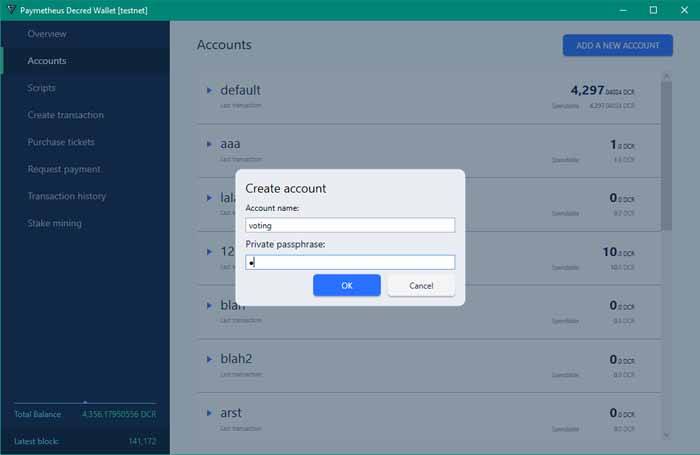
There’s a fair bit of information here, so we’ll go through each of the options.
- Ticket difficulty - The current price of a ticket.
- Blocks until retarget - When this reaches 0, a new ticket price is calculated.
- Source account - This is the account that will purchase the tickets and receive the reward.
- Tickets to purchase - The number of tickets to purchase.
- Ticket fee (DCR/kB) - Tickets are entered into the voting pool by order of their fee. In times of high demand, you will need to increase this value in order to have your tickets accepted. You can view current ticket fees here.
- Split fee (DCR/kB) - Paymetheus uses a “split” transaction to avoid blocking your balance, splitting the exact amount needed for the ticket from the balance in your wallet. The “split” transaction needs to be confirmed at least once before you can reuse your balance. This can block your whole balance for several minutes while this confirmation occurs. Without the split, you would have to wait for the confirmation of the ticket transaction, which could take several hours. This can be left at 0.01. It does not affect your chances of buying tickets or voting with them.
- Expiry (blocks) - Often ticket fees will increase during a window and you may be stopped out by higher fees. By setting an expiry, tickets that are not mined by the given block height are cancelled so you can try again with higher fees if you wish. If this is empty, they will not expire until the end of the window.
- Stake pool preference - Automate setup with PoS pools. See below for more information.
- Voting address - The Decred address that will do the voting. Solo and custom pool miners only.
- Pool fee address - For those using a custom pool.
- Pool fees (%) - For those using a custom pool.
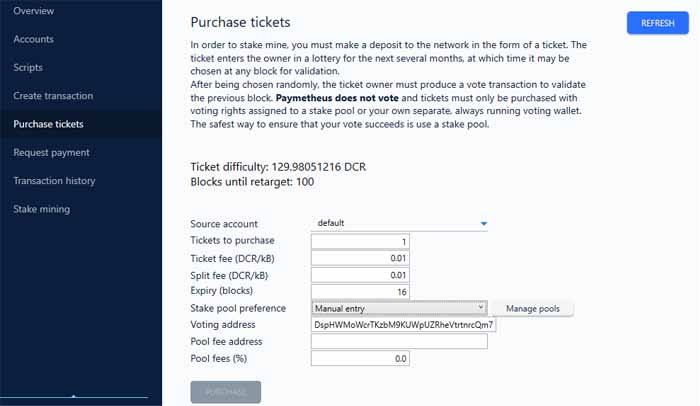
To easily set up ticket purchasing for a stake pool, click the ‘Manage pools button’. If you haven’t already, you’ll need to register with a stake pool (see above). Once you’ve registered, log in, look for your API key, and copy it. Select the pool you just registered with from the drop down.
- Overview - Table of Contents
- What Is Decred?
- Getting Started With Decred
- How To Get A Decred Wallet?
- Decred Resources
- How To Buy Decred?
- How To Earn Decred?
- What Is Decred Mining?
- Latest Decred News
Paste the key into the ‘API key’ box and click ‘Save’. You should see a bunch of letters and numbers appear in the bottom box. Click ‘Close’. You can now purchase tickets by clicking the ‘Purchase’ button!
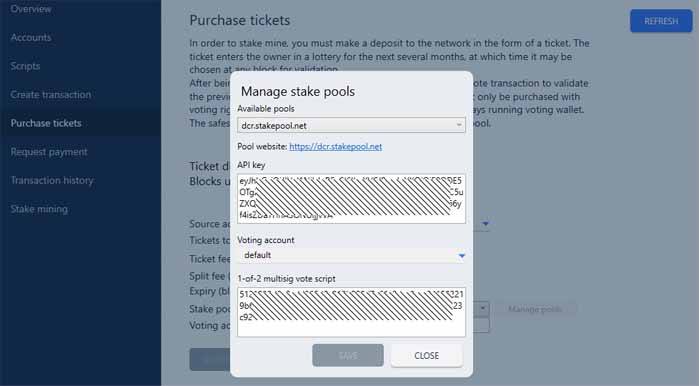
Request Payment
This is where you can generate wallet addresses to give to other people so they can send you DCR. Simply choose the account you want funds to go to and press Generate Address. Copy the address (it’s the top line that starts with Ds) and share that with the other person.
Decred addresses can be used as many times as you want, but for privacy reasons it’s best to generate a new one for each transaction. There’s around 1.4E48 (that’s 14 followed by 47 zeroes) addresses available so you don’t need to worry about running out.
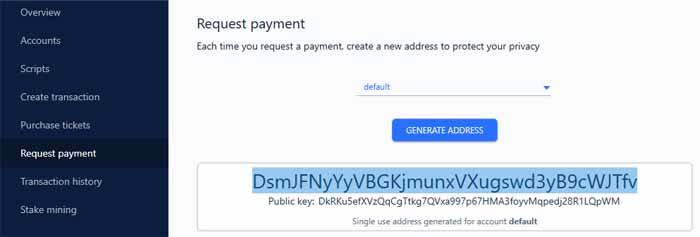
Transaction History
This tab shows a list of all transactions that have occurred. The transaction hash can be used with the block explorer to see more information about the transaction.
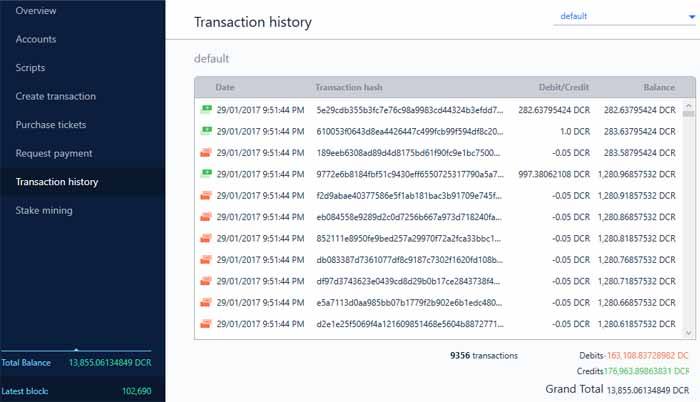
Stake Mining
This tab shows some statistics on the PoS network:
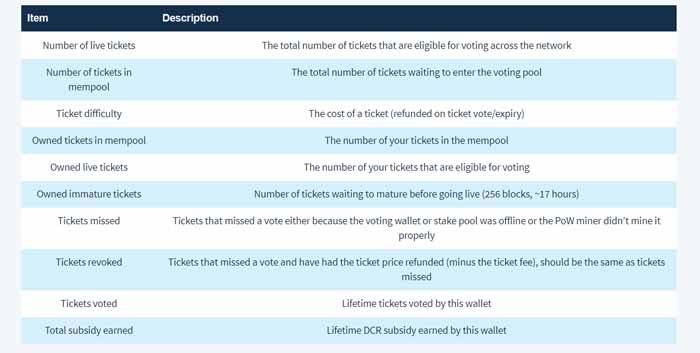
Decred Resources
How To Buy Decred?
The five basic ways are:
- Purchase Decred for BTC Through an Exchange
- PoW Mine for Decred
- PoS Mine for Decred (this requires you to already have some Decred)
- Contribute to Decred
- Sell / Trade Goods or Services with someone who already has Decred.
Purchasing Decred
One way to acquire Decred is to purchase some on an exchange.
Bitcoin
Note: Due to Decred’s early stages of development and adoption, Bitcoin must be traded for Decred, fiat currency cannot be used. If you already have some Bitcoin, move ahead to the next section. If you do not have any Bitcoin, the procedure for obtaining some has been well documented in the Bitcoin wiki.
Exchanges
Since the release of Decred on February 8th, 2016, there are four currency exchanges where you can buy or sell Decred (as of February 2017). We hope this list will grow as time goes on.
- Poloniex
- Bittrex
- Bleutrade
- Tux Exchange
You will need to create an account on one of these sites, send your Bitcoin to this new account, and submit an order for Decred at a price of your choosing. When your order is fulfilled, you will need to withdraw your new Decred and send it to your Decred wallet.
Direct Exchanges
As Decred continues to grow in popularity, some exchanges are offering Decred directly for fiat currency.
- Changelly
Mine for Decred (PoW)
Proof-of-Work (PoW) is a measure of using computational power to create and verify the cryptographically secure blockchain. This is similar to traditional Bitcoin mining. PoW mining is described in more detail here.
Stake Mine for Decred / Proof-of-Stake (PoS)
Proof-of-Stake (PoS) mining is performed by stakeholders who lock a certain amount of their DCR in return for voting rights and a monetary reward. PoS mining is described in more detail here.
Contribute to Decred
Decred is currently recruiting contractors - members of the community who are paid in Decred for their contributions. Check out this blog post for the details and how to get involved.
Sell / Trade Goods or Services for Decred
An alternative to obtaining Decred is to use your skills, knowledge, or experience by exchanging services for Decred as payment. Services can be anything that you are skilled at which are in need or requested by other members of the Decred community.
How To Earn Decred?
Voting Overview</h4.
There is a two-phase process for voting to implement consensus changes that would create a hard fork.
The first Phase is meeting the upgrade threshold on the network. A majority of PoS/PoW nodes on the network must upgrade before voting can begin. This is measured in the following ways:
- For PoW, at least 95% of the 1000 most recent blocks must have the latest block version.
- For PoS, 75% of the votes cast within a static 2016 block interval must have the latest vote version.
The second phase is the voting itself. Voting takes place within a static 8064 block interval. If 75% of votes mined within that interval signal a ‘yes’ vote to the proposals, the changes are implemented. Implementation happens after one additional block interval to allow any remaining nodes to update prior to the fork.
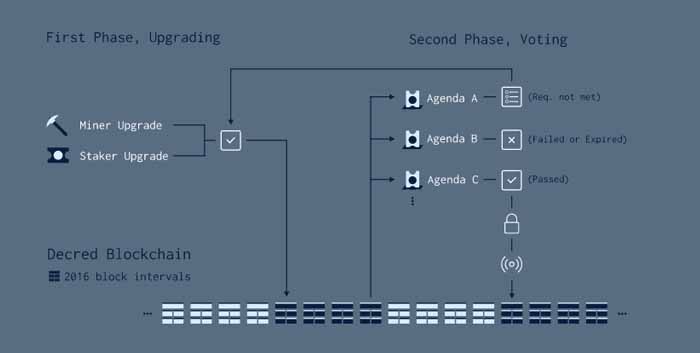
Where To Spend Decred?
Decred (/ˈdi:ˈkred/, /dɪˈkred/, dee-cred) is an open, progressive, and self-funding cryptocurrency with a system of community-based governance integrated into its blockchain. The project mission is to develop technology for the public benefit, with a primary focus on cryptocurrency technology. Decred, as a currency and as a project, is bound by the following set of rules, which include guiding principles, a system of governance, and a funding mechanism. These rules have been established in an effort to create an equitable and sustainable framework within which to achieve Decred‘s goals.
Principles
- Free and Open-Source Software - All software developed as part of Decred shall be free and open source-software.
- Free Speech and Consideration - Everyone has the right to communicate opinions and ideas without fear of censorship. Consideration shall be given to all constructive speech that is based in fact and reason.
- Multi-Stakeholder Inclusivity - Inclusivity represents a multi-stakeholder system and an active effort shall be maintained to include a diverse set of views and users. While it would be ideal to include everyone, Decred shall comply with all relevant bodies of law in the jurisdictions where applicable, such as embargoes and other trade sanctions.
- Incremental Privacy and Security - Privacy and security are priorities and shall be balanced with the complexity of their implementations. Additional privacy and security technology shall be implemented on a continuing and incremental basis, both proactively and on-demand in response to attacks.
- Fixed Finite Supply - Issuance is finite and the total maximum number of coins in Decred shall not change. The total maximum supply for Decred is 20,999,999.99800912 coins, with a per-block subsidy that adjusts every 6,144 blocks (approximately 21.33 days) by reducing by a factor of 100/101. The genesis block subsidy starts at 31.19582664 coins.
- Universal Fungibility - Universal fungibility is fundamental to Decred being a store of value and attacks against it shall be actively monitored and countermeasures pursued as necessary.
Blockchain Governance
- Governance of the network occurs directly through the blockchain via hybridization of a block’s proof-of-work (“PoW”) with its proof-of-stake (“PoS”). PoS contributors, known as stakeholders, can effectively override PoW contributors, known as miners, if 60% or more of the stakeholders vote against a particular block created by a miner.
- A lottery system is used to determine which stakeholders vote on each block and collect a subsidy.
- To be a stakeholder, one must purchase one or more tickets, which entails locking a specified amount of coins for approximately 1 day (256 blocks).
- After waiting for the ticket to mature, the ticket is entered into a lottery that runs once per block where the winning tickets gain the ability to vote on the previous block.
- Stakeholders must wait an average of 28 days (8,192 blocks) to vote their tickets, and during this time the coins used to purchase the ticket remain locked. The wait may be much longer or shorter than the average of 28 days because the ticket selection process is pseudorandom. Tickets expire after approximately 142 days (40,960 blocks).
- Stakeholder votes recorded in the blockchain are rewarded with 6% of each block subsidy, and each block can have up to 5 votes for a total of 30% of each block subsidy.
- PoW receives 60% of each block subsidy, subject to the constraint that their subsidy scales linearly with the number of PoS votes included, e.g. including 3 of 5 votes reduces PoW subsidy to 60% of the maximum.
- The votes themselves decide by majority decision whether the general transaction tree of the previous block, including the PoW subsidy, is valid. Thus, if PoS voters vote against a particular PoW block, it destroys the PoW subsidy (and development subsidy) and invalidates any regular transactions within that block.
- Additional vote bits may be set when stakeholders submit votes, allowing stakeholders to vote on matters besides the previous block.
Project Governance
- Off-chain decision-making shall be used to resolve disputes related to development and voted on by the Decred Assembly as they arise, as an effective proof-of-assembly (“PoA”), until such time PoA is integrated into the blockchain.
- The Decred Assembly shall be composed of diverse Assembly members who are selected for membership by the Admission Council from the project ecosystem for representation.
- Councils that are composed of Assembly members shall be formed to address ongoing and episodic matters. The initial Councils shall serve the separate functions of admission (Admission Council), creation (Creation Council), and attrition (Attrition Council).
- The Admission Council shall vote on the inclusion of new members into the Assembly. All additional Councils shall be created by the Creation Council. The Attrition Council shall be responsible for deactivating both Councils and Assembly members as necessary.
- Membership of the Decred Assembly shall consist of Assembly members who have been confirmed by a 60% or greater affirmative vote by the Admission Council. There is no restriction on the age or nationality of Assembly members, the only requirement is that of merit as judged by the Admission Council. Merit is judged on the basis of two characteristics: (1) the amount of time over which one has been involved with the project, and (2) one’s body of work and its impact in the context of the project.
- Attrition is embraced by temporarily deactivating or actively expelling Assembly members by a 60% or greater affirmative vote by the Attrition Council on the basis of: (1) substantial non-fulfillment of duties for one or more Councils or the Assembly, and/or (2) counterproductive behaviour that goes against the framework set forth in the Constitution without constructive action toward solutions.
- All matters formally presented to a Council shall be resolved by a vote in 365 days or less.
Funding
- Sustainability and longevity require that a subsidy of 10% of all block rewards be given to a development organization on an ongoing basis. The initial development organization shall be Decred Holdings Group LLC (“DHG”), a Nevis LLC that is responsible for funding work related to the development of the project, such as software development, infrastructure, and awareness.
- DHG shall only fund work that adheres to the guiding principles.
- DHG shall issue public financial statements every six months, starting March 8th, 2016. The frequency of financial statements may increase with activity, but it shall not occur more often than quarterly.
- DHG shall put forth a budget proposal each year on March 8th, after the corresponding public financial statement has been issued.
- The Funding Council shall review, propose changes, make changes, and ultimately approve the proposal by April 8th, one month from the initial budget proposal.
- Final approval of the budget via PoA vote shall occur after Funding Council approval by April 18th, two months from the initial proposal.
- DHG shall make public requests for proposals (“RFPs”) for projects that are to be completed by parties on a contractual basis. RFPs shall include a scope and an explanation of how the work shall benefit the project. Parties that submit proposals shall be required to include: (1) a detailed description of the work to be performed, (2) a series of milestones that can be verified as work is completed, and (3) a quote for the work, itemized by milestone, in U.S. Dollars (“USD”).
- All proposals, both submitted and accepted, shall be made public one week after a proposal has been selected. Once the selection occurs, the associated RFP shall be removed. Contracted parties shall be paid exclusively in decred (“DCR”) at the current effective DCR/USD rate at the time of payment, unless specifically noted otherwise.
- In the future, the development organization may need to change from DHG to another entity that serves an identical function. If and when this occurs, DHG shall transfer all assets to the new entity and the development subsidy shall be directed to the new entity.
What Is Decred Mining?
Proof-of-Stake (PoS) Mining
This document is meant to be an educational resource for Proof-of-Stake mining (staking) with Decred. It will cover the purpose of the Proof-of-Stake protocol, a brief introduction to the staking process, a ticket lifecycle, and get you started with ticket buying.
Overview
Decred’s unique Proof-of-Stake protocol serves multiple purposes:
- Overview - Table of Contents
- What Is Decred?
- Getting Started With Decred
- How To Get A Decred Wallet?
- Decred Resources
- How To Buy Decred?
- How To Earn Decred?
- What Is Decred Mining?
- Latest Decred News
To provide a metric for stakeholders/end-user support of any consensus updates. That is, stakeholders are able to vote on specific proposals/agenda on the Decred blockchain. Agendas may include deciding whether or not the dev team spends time implementing a specific feature, activating the code of a feature already submitted for implementation, or making other decisions such as how the dev subsidy should be spent. More information on voting can be found in our Mainnet Voting Guide.
Decred’s PoS also provides a system of checks and balances for nonconforming miners. Stakeholders can vote a block invalid if it doesn’t match to the consensus rules of the network.
Staking 101
To participate in proof-of-stake mining, stakeholders lock some DCR in return for a ticket. Every ticket owned gives a stakeholder the ability to cast a single vote. Upon voting, each ticket returns a small reward plus the original Ticket Price of the ticket.
Each ticket is selected to vote at random, giving an average vote time of 28 days, but possibly requiring up to 142 days, with a .5% chance of expiring before being chosen to vote (this expiration returns the original Ticket Price without a reward). Every block mined must include 5 votes (Miners are penalized by a reward deduction if less than 5 votes are included).
Every block mined can also include up to 20 fresh ticket purchases. A new ticket requires 256 block to mature before it is entered into the *Ticket Pool and able to be called upon to vote.
There are a few important variables that you should familiarize yourself with while staking.
Every 144 blocks (~12 hours), the stake difficulty algorithm calculates a new Ticket Price in an attempt to keep the Ticket Pool size near the target pool size of 40,960 tickets. This 144 block window is referred to as the StakeDiffWindowSize.
The Ticket Price/Stake Difficulty is the price you must pay for a ticket during a single 144 block window.
The Ticket Pool is the total number of tickets in the Decred network.
The Ticket Fee (ticketfee) is the fee rate that must be included in the ticket purchase to incentivize Proof-of-Work miners to include that ticket in a new block. Ticket Fee usually refers to the DCR/kB fee rate for a ticket purchase transaction.
Therefore, with a higher transaction size, you will end up paying a higher absolute fee. For example, solo-staking ticket purchases are around 300 Bytes, which means a Ticket Fee of .3 DCR/kB will result in the spending on .1 DCR if, and only if, that ticket gets included in a block.
When the Ticket Price gets relatively low for a single Ticket Window, you can usually expect a fee market to form, with many stakeholders trying to buy tickets before the window ends. When the Ticket Price is not at an extremely low and profitable price, the default Ticket Fee of 0.001 DCR/kB rate is usually high enough to be included in a block.
When a ticket is called to vote, the wallet that has voting rights for that ticket must be online. If the wallet is not online to cast its vote, the ticket will be marked as missed and you will not receive a reward for that ticket. Stakepools are offered as a solution for those that cannot have a voting wallet online 24/7.
Stakepools allow stakeholders to generate ticket purchase transactions that give a stakepool voting rights for your ticket. They vote on your behalf, usually requiring a small fee for participation (under 7%) which covers the cost of hosting the minimum of 3 servers required to run a stakepool. This fee is known as the Pool Fee and is only taken out of the small PoS reward. A list of stakepools can be found below.
Ticket Lifecycle
Purchasing a ticket for PoS is quite simple (see below) but what happens to it after you buy it? A ticket on main net (test net uses different parameters) will go through a few stages in its lifetime:
- You buy a ticket using a Paymetheus or dcrwallet wallet. The total cost of the each single ticket transaction should be Ticket Price + Ticket Fee(ticketfee).
- Your ticket enters the mempool. This is where your ticket waits to be mined by PoW miners. Only 20 fresh tickets are mined into each block.
- Tickets are mined into a block in with higher Ticket Fee transactions having a higher priority. Note that the Ticket Fee is DCR per KB of the transaction. A few common transaction sizes are 298 Bytes (a solo ticket purchase) and 539 Bytes (a pool ticket purchase).
- A - If your ticket is mined into a block, it becomes an immature ticket. This state lasts for 256 blocks (about 20 hours). During this time the ticket cannot vote. At this point, the ticket fee is non-refundable.
- B - If your ticket is not mined, both the Ticket Price and Ticket Fee are returned to the purchasing account.
- After your ticket matures (256 blocks), it enters the Ticket Pool and is eligible for voting.
- The chance of a ticket voting is based on a Poisson distribution with a mean of 28 days. After 28 days a ticket has a 50% chance to have already voted.
- Given a target pool size of 40960 tickets, any given ticket has a 99.5% chance of voting within ~142 days (about 4.7 months). If, after this time, a ticket has not voted, it expires. You receive a refund on the original Ticket Price.
- A ticket may miss its call to vote if the voting wallet does not respond or two valid blocks are found within close proximity of each other. If this happens, you receive a refund on the original Ticket Price.
- After a ticket has voted, missed, or expired, the funds (ticket price and subsidy if applicable, minus the fee) will enter immature status for another 256 blocks, after which they are released. If a ticket is missed or expired, a ticket revocation transaction is submitted by the wallet which then frees up the locked ticket outputs. NOTE: Revocations can only be submitted for a corresponding missed ticket. You cannot revoke a ticket until it is missed.
Latest Decred News
Hard Forks Done Right — It’s Decred’s Time to Shine!
In late 2015 a group of Bitcoin developers proposed a solution to the governance crisis plaguing the Bitcoin network. As the creators of btcsuite — an alternative full node implementation of Bitcoin written in Go — they had first-hand experience of the problem.
In a series of blogs, the team highlighted the extent of Bitcoins governance issues. To them it was clear, in order solve the problem they had to go back to basics, right back to zero to build a new cryptocurrency from the ground up, on the foundations decentralised governance. Shortly after, the group, known as Company Zero (c0), announced the launch of Decred — a new cryptocurrency that not only solved Bitcoins governance issue but extended the technology of Bitcoin itself.
- Overview - Table of Contents
- What Is Decred?
- Getting Started With Decred
- How To Get A Decred Wallet?
- Decred Resources
- How To Buy Decred?
- How To Earn Decred?
- What Is Decred Mining?
- Latest Decred News
Aside from funding, Bitcoin’s main governance problem relates to its inability to make decisions effectively. More specifically, the problem revolves around who ultimately decides to hard fork to a new set of consensus rules, and how. To allow us to better understand how Decred has solved the governance problem, this blog will examine how both Bitcoin and Decred make consensus change (hard fork) decisions.
